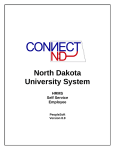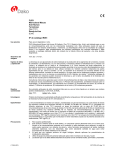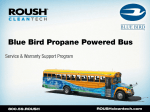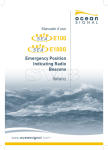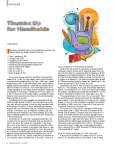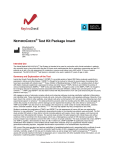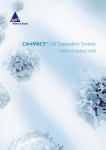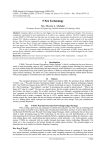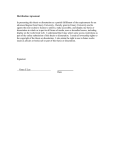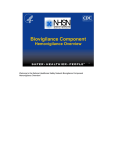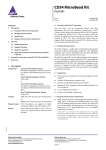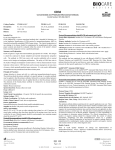Download CD34 Reagent System - Atlanta Pediatric Research
Transcript
... &'"• ,~ .J!. / Institutional Review Board Phone: (404) 785-7477 Fax: (404) 785-947 [email protected] http://www.choa.org/clinicalresearch A Children's·H Healthcare of Atlanta For faster processing, contact the IRB prior to submission. EMERGENCY USE OF A TEST ARTICLE Must be reported within 5 days of emergency use Emergency use is defined as the use of a test article (e.g., investigational drug or biologic) on a human subject in a lifethreatening situation in which no standard acceptable treatment is available and there is not sufficient time to obtain IRB approval for use. 21 CFR 50.23(a)(c), 21 CFR 50.24, 21 CFR 56.102(d)(l), 21 CFR 104(c) REPORT TO FDA • • Drugs: The physician or sponsor is responsible for submitting a new IND, or an amendment to an existing IND, to the FDA within 15 working days of FDA's authorization of the use. Clearly mark as "Emergency IND ". See FDA website for Phvsician Request for an Indi vidual Patient IND under Expanded Access for Nonemergency or Emer!!ency Use; Fonn FDA 1571; Form FDA 157llnstructions Devices without an/DE: Physician must report the use to the FDA (CDRH or CBER) within 5 worki11g days. After a first use of the device for emergency we request that the PI evaluate the need for an IDE and provide the IRB with an update. BASIC INFORMATION Name of Test Article and Brief Description: CliniMacs CD34 Reagent System : Authorized by U.S. Federal law for use in the treatment of patients with acute myeloid leukemia (AML) in first complete remission; The CliniMACS® CD34 Reagent System is indicated for processing hematopoietic progenitor cells collected by apheresis (HPC, Apheresis) from an allogeneic, HLA- identical , sibling donor to obtain a CD34+ cell-enriched population for hematopoietlc reconstitution following a myeloablative preparative reg imen without the need for additional graft versus host disease (GVHD) prophylaxis in patients with acute myeloid leukemia (AML) in first morphologic complete remission. IND/IDE #: Date of Use of Test Article: Approximately July 1, 2015 An attached narrative of the situation and use of the test article must be included with the submission of this form. Attending Physician/PI Dr. John Horan Institution CHOA Department/Division Aflac-BMT 413-717-2542 Email [email protected] Audrey Tumlin Phone 404-785-2125 [email protected] Phone . ALTERNATE CONTACT (Coordinator/Admin Contact) Email EMERGENCY USE INFORMATION Date of Use of Test Article: Approximately July 1, 2015 Was the situation life-threatening or severely debilitating? If yes. please describe: Her first graft failed, leaving her with severe pancytopenia and no immune [gj YES 0No system to fight her CMV infection or other infections that arise Emergency Use of a Test Article Form , version 4-2014 Page 1 of 3 Is there a standard acceptable treatment available? If no, please describe: The patient' s sibling donor is only partially HLA matched. Because of the high risk for graft versus host disease with partially matched donors, the standard measures for preventing graft versus host disease are inadequate. Several investigational measures are now being employed in this setting. CD34 selection is one strategy that has shown promise . OvEs rgj NO Was there sufficient time to obtain IRS approval? If no, please describe: only 8 days for approval , FDA requires 30 days OvEs rgj Was Informed Consent sought? We Qlan to obtain informed consent from the Qatlent and Qarents Qrior to July 1, 2015 If yes , please describe the consent process and provide documentation of informed consent: If no, provide a copy of the evaluation of PI and independent physician justifying criteria for a waiver of consent (see policy 1.60 ). OvEs 0No NO Is th is the first use of this test article or do you plan to use this test article again in the future? If yes , you must complete the initial submission form and provide applicable documents. Subsequent uses of rgj NO OvEs a test article typically require full and prospective IRS review or explain why an IND/I DE has not been obtained to date. Describe subject's medical condition prior to and following treatment with the test article: PRIOR TO (wi ll not use test article until July 1, 20 15 ) The patient has a life threatening CMV infection . W ithout another transplant, she is likely to die from it in the next couple of months. INVESTIGATIONAL DRUG OR BIOLOGIC If this emergency use does not involve a drug or biologic, please skip to the next section. IND held by: D Sponsor U Investigator Manufacturer: Has the sponsor agreed to the use of this drug or biologic for this subject? OvEs 0No Has the FDA given permission for this use and this subject? If yes, provide FDA IND letter. OvEs 0No INVESTIGATIONAL DEVICE Risk Determination: [g) Significant The device removes most of the lymphocytes from the donor graft and, thereby, reduces the risk for graft versus host disease . Wh ile lymphocytes f rom donor are responsible for causing graft versus host d isease, they also resto re the patient's immune system after they go through a bone marrow transplant . The donor's lymphocytes make it possib le to f ight a variety of infections includ ing CMV. CD34 selection slows the recovery of the immune function after transplant . However, this risk is re lative. A transp lan t w ith CD34 selection will provide her with greate r immunity than she has now. And ove r time, her immune function will improve. In essence the CD34 se lection aims to balance the benefit and harm associated with the donor's lymphocytes by removing some, but not all of the lymphocytes. Manufacturer: D Non-Significant Miltenyi Biotec Has the sponsor agreed to the use of this drug or biologic for this subject? rgj YES 0No Has the FDA given permission for this use and this subject? If yes , provide FDA IDE letter. OvEs rgj NO ATTENDING PHYSICIAN'S SIGNATURE The signature of the attending physician certifies that he/she acknowledges responsibility for (1) the ethical conduct of the treatment while using an emergency use test article in protecting the rights and welfare of human research subjects; (2) the timely reporting of al l required information. The attendino physician assures that the information in this application is correct and all procedures performed Emergency Use of a Test Article Form, version 4-2014 Page 2 of 3 Use guidelines were conducted in strict accordance with all applicable Federal, State and local regulations and -:-----::-""f--:::7----:--~:-:::":"-:_-c_ti-on-of_h_u_m_a_n_s_ubjects reseano~ t-JV\ In Printed Name iio.r tr'Date - '"]? 6 28 I 6 INDEPENDENT PHYSICIAN SIGNATURE Nj-he patient was confronted by a life-threatening or severely debilitating situation necessitating use of the test article. ~ No alternative method of approved or generally recognized therapy was available that provided an equal or greater likelihood of the life of the patient. 12S-Infonmed consent was obtained OR infonmed consent could not be obtained because of an inability to obtain legally effective consent or parental permission . ~ng lodep~~wp Emergency Use of a Test Article Form, version 4-2014 Date Page 3 of 3 ATTACHMENT A Institutional Review Boat·d (IRB) Information 1. Please Provide the F W A Number ass igned to the IRB that oversees clin ical trial acti vities within your Institu tion: 00000644 FW A Number: ----------------------------------- No further information is necessary i(an FWA Number is provided. 2. lfyour Institution does not have an FWA Number, please provide the following infonn ation : a. The lRB name, if any, used by the institution or organization (e.g., State University Behavioral IRB or University Healthcare BiomedicallRB): b. Complete Mailing Address of the ffi.B , including City, State and Zip; plus country if outside the USA: c. Telephone Number(s) for IRB : d. Fax Number for IRB : e. IRB Chairperson a . Full Name: b. Title or Position: c. Eamed Degree(s): f. In lieu of providing IRB Member infonnation in the table below, the Chairperson of the IRB may attest that the ffiB is du ly constituted and complies with 21 CFR parts 50 and 56. Links are as follows: http ://www.accessdil ra. fda . r:wviscripts/cclrh/c fdoc s/c tc fr/CFRSearch.c fin ?CFRPart= 50 http: //ww w .accessda ta. fda. !.Wv/scri pts/cdrh/c f'clocs/c fc fr/CFRSearc h .c fin ?C FRPart= 56&showFR = I 5 As Chairperson for the Institutional IRB r·eferenced above in Section 2, I attest that our Institutional Review Board complies with the FDA 21 CFR Parts 50 and 56. RESEARCH INSTITUTION Children's Healthcare of Atlanta, Inc. DATE: _ a_A_'2-_s.f_ . . . ~--- READ AND ACKNOWLEDGED: INSTITUTIONAL REVIEW BOARD CHAIRMAN: (PRINT NAME) INSTITUTIONAL REVIEW BOARD CHAIRMAN (SIGNATURE) Carlton Dampier, MD ~~ If section 2.f. is not completed by the Chairman, please complete the table below to identify all IRB Mem.bers approving the use oftlte CliniMACSW CD34 Reagent System as a Humanitarian Use Device: Member Name (Last, First) Earned Degree(s) Scientist (S) or Nonscientist (N) Primary Scientific or Nonscientific Specialty Affiliation with lostitution(s) YIN ], 2. 3. 4. 5. 6. 7. 8. 9. 10. II. 12. Please return this form to your Clinical Applications Manager, or Fax to 1-831-417-9621 6 Attachment B (On Institutional Letterhead) Notice of IRB Approval for the CliniMACS® CD34 Reagent System as a Humanitarian Use Device Date: Miltenyi Biotec Incorporated 85 Hamilton Street Cambridge, MA 02139 Phone: 617-218-0030 Fax: 1-831-417-9621 Regarding: lRB Approval of the CliniMACS"" CD34 Reagent System as a Humanitarian Use Device To Whom It May Concem: The letter certifies that the CliniMACS'"' CD34 Reagent System has been reviewed and approved by our Institutional Review Board (IRB) for Use as a Humanitarian Use Device. During the review of this Project, tbe IRB specifi cally considered (i) the risks and anticipated benefits, if any, to subjects; (ii) the selection of subjects; (iii) (iv) the safety of subjects; and (v) the privacy of subjects and confidentiality of the data. It is agreed that any and all adverse event(s) that occur when using the CliniMACS-:.' CD34 Reagent System will be reported in accordance with the Medical Device Reporting Regulations, including notification to Miltenyi Biotec Incorporated at the address and/or fax number listed above. Signed: a~~-~ ~~ Print Name: Carlton Dampier, MD IRB Chainnan or Treating Physician: ltVB~ Institution : Children's Healthcare of Atlanta, Inc. Address : 1687 Tullie Cir Atlanta. GA 30329 Email Address: irh@choa org Phone: 404-785-7477 7 Transplant Treatment Consent Infusion of hematopoietic stem cells Patient Name: Tishanna Mitchell MR#: 703387 Emory University School of Medicine and Children’s Healthcare of Atlanta Consent for Transplant Treatment Treatment Title: Infusion of Allogeneic Hematopoietic Stem Cells Primary BMT Physician: Dr. Lakshmanan Krishnamurti If you are the parent or legal guardian of a child who is to have a transplant, the term “you” used in this consent form means “your child.” INTRODUCTION: We are recommending that you have an infusion of allogeneic hematopoietic blood stem cells. This is because of partial graft failure. Before you can decide whether or not to have this treatment, you must understand the treatment, how it may affect you, the risks, alternatives, and what is expected of you. This process is called informed consent. PROCEDURES AND TREATMENT The treatment will be done at Emory University/Children’s Healthcare of Atlanta, Egleston Hospital, in the Aflac Cancer and Blood Disorders Center. A physical exam and laboratory tests will be done before the cells are given. INFUSION OF BLOOD STEM CELLS Blood will be collected from your sister after she has taken a medicine that causes stem cells to enter the blood from the bone marrow. . The blood collected from her will also contain white blood cells that can cause graft versus host disease. To prevent graft versus host disease, we will remove most of these white blood cells, using a technique called CD34 selection (We can tell you more about how CD34 selection works if you like). The blood stem cells are given through the central line or IV, like a blood transfusion, over several minutes. The cells then travel to the bone marrow, where they should grow and make new blood cells. After the cells are infused, you will need to be monitored for about 4 to 6 more hours. During this time, we will treat you for side effects. RISKS AND SIDE EFFECTS There can be side effects of infusing blood stem cells. Most patients have few side effects during and immediately after the infusion. The side effects that do happen typically pass rapidly. . Rarely, patients can have blockage of blood vessels causing damage to organs (lungs, kidneys, brain) from small clots. In rare cases, patients have allergic reactions (may be life-threatening) or infections from the infusion. There are also potential side effects of CD34 selection. Because it removes white blood cells, it may take many months for your immune system to get strong. During this time, you will remain more susceptible to infections. They may be life threatening. GRAFT FAILURE AND GVHD It is possible that the blood stem cells will not grow well in your bone marrow. This could leave you without working bone marrow cells, which may cause life-threatening complications. It is also possible that even with the CD34 selection, you may still get graft versus host disease. Page 1 Transplant Treatment Consent Infusion of hematopoietic stem cells Patient Name: Tishanna Mitchell MR#: 703387 WHAT WILL BE DONE TO MINIMIZE RISKS You will be given medications before the infusion to try and prevent these reactions. Your BMT doctor and staff will be checking closely to see if any of these side effects are happening. If possible, we will try to prevent undesirable side effects. If they happen, we will give treatment to control them, such as medication for nausea. Your doctors and nurses will watch you carefully for infection. They will use medicines and other treatments to try and prevent infections. If you develop infections, they will treat you. These treatments, though, do not always work. ALTERNATIVES TO THIS TREATMENT You may choose not to have the infusion of blood stem cells. Please discuss all the options with your doctors, and ask all of the questions that you have. Alternatives include: • • Not having the blood stem cells infused, but getting supportive care such as antibiotics to treat infections and blood transfusions for low blood counts. Research studies with new treatments; if available (your doctor can discuss what may be available for you). CONTACT PERSONS If you have any questions about this treatment, contact your BMT physician. If you believe you have been injured by this treatment, you should contact your BMT physician. SIGNATURE FOR DOCUMENTATION OF CONSENT We will give you a copy of this consent form to keep. If you agree to this treatment, please sign below. _____________________________________ Print patient’s name _____________________________________ Patient, Parent or legal guardian ___________ __________ Date Time _____________________________________ Person Obtaining Consent ___________ __________ Date Time Page 2 Rx only For in vitro use only. Humanitarian Device: Authorized by U.S. Federal law for use in the treatment of patients with acute myeloid leukemia (AML) in first complete remission. The effectiveness of the device for this use has not been demonstrated. Indications for use The CliniMACS® CD34 Reagent System is indicated for processing hematopoietic progenitor cells collected by apheresis (HPC, Apheresis) from an allogeneic, HLAidentical, sibling donor to obtain a CD34+ cell-enriched population for hematopoietic reconstitution following a myeloablative preparative regimen without the need for additional graft versus host disease (GVHD) prophylaxis in patients with acute myeloid leukemia (AML) in first morphologic complete remission. CONTRAINDICATIONS Do not use CD34+ cells prepared with CliniMACS® CD34 Reagent System in patients with known hypersensitivity to murine (mouse) proteins or iron-dextran. surface CD34 antigen found on hematopoietic progenitor cells, the system enriches CD34+ cells from HPC, Apheresis by passing the antibody-labeled cell suspension through a separation column with a strong magnetic gradient. The separation column retains the magnetically labeled CD34+ target cells while unlabeled cells flow through and are collected in the Negative Fraction Bag. Several automated washing steps are performed, disposing most of the liquid into the Buffer Waste Bag. The magnetically-selected CD34+ cells are released from the separation column when the magnet is disengaged, removing the magnetic field, and the target CD34+ cells are eluted into the Cell Collection Bag. Do not infuse the CliniMACS® CD34 Reagent or the CliniMACS® PBS/EDTA Buffer into patients directly. DESCRIPTION • Hypersensitivity Reactions The CliniMACS® CD34 Reagent System is a medical device system that consists of the following components: Hypersensitivity reactions, including anaphylaxis, have been observed during infusion of CD34+ cells from the CliniMACS® CD34 Reagent System. Monitor the patient for hypersensitivity reactions, including anaphylaxis, during infusion of CD34+ cells from the CliniMACS® CD34 Reagent System. • • • CliniMACS® CD34 Reagent - dark amber, nonviscous, colloidal solution containing an antibody conjugate in buffer. The conjugate consists of a murine IgG1 monoclonal antibody directed against the Class II epitope of the human CD34 antigen, which is chemically conjugated to dextran beads having an iron oxide/hydroxide core. (See the CliniMACS® CD34 Reagent Package Insert for more information.) • Engraftment failure Failure to infuse an adequate number of functioning CD34+ cells can result in engraftment failure. Collect sufficient HPC, Apheresis to yield at least 2.4 × 106 CD34+ cells per kg of patient body weight after system processing (see Device Performance below). The clinical trial (see Clinical Performance below) using the CliniMACS® CD34 Reagent System to process HPC, Apheresis did not test allografts with less than 2.4 × 106 CD34+ cells per kg of recipient body weight. Monitor patients for laboratory evidence of hematopoietic recovery after transplantation. CliniMACS® plus Instrument - software-controlled instrument that processes the HPC, Apheresis. (See the CliniMACS® User Manual for the CD34 Reagent System for more information.) CliniMACS® Tubing Set TS or Tubing Set LS - a single-use, sterile, disposable tubing set with two proprietary cell separation columns. The CliniMACS® Tubing Set TS is for processing HPC, Apheresis preparations containing up to 0.6 × 109 CD34+ cells out of a total cell number not exceeding 60 × 109 white blood cells. The CliniMACS® Tubing Set LS is for larger scale preparations containing up to 1.2 × 109 CD34+ cells out of a total cell number not exceeding 120 × 109 white blood cells. (See the CliniMACS® Tubing Sets Package Insert and the CliniMACS® User Manual for the CD34 Reagent System for more information.) CliniMACS® PBS/EDTA Buffer - a sterile, isotonic phosphate-buffered, 1 mM EDTA, saline solution, used as external wash and transport fluid for the in vitro processing of HPC, Apheresis. (See the CliniMACS® PBS/EDTA Buffer Package Insert and the CliniMACS® User Manual for the CD34 Reagent System for more information.) • Acute and chronic graft versus host disease (GVHD) GVHD can occur in patients who receive HPC, Apheresis processed using the CliniMACS® CD34 Reagent System. Use pharmacologic prophylaxis if more than 1 × 105 CD3+ cells per kilogram of recipient body weight are infused. • Delayed immune reconstitution after transplantation Removal of T cells from the HPC, Apheresis can delay immune reconstitution after transplantation. Patients who receive the CD34+ cell-enriched population prepared using the CliniMACS® CD34 Reagent System are at risk for serious opportunistic viral infections, including post-transplant lymphoproliferative disorder caused by Epstein-Barr virus (EBV) and cytomegalovirus (CMV). Monitor for EBV and CMV in the peripheral blood of patients after transplantation and initiate appropriate treatment promptly. PRINCIPLES OF OPERATION The CliniMACS® CD34 Reagent System is an in vitro medical device system used to select and enrich CD34+ cells from HPC, Apheresis while passively depleting other cells, such as CD3+ T cells, which cause graft versus host disease. The system is based on “magnetically-activated cell sorting” (MACS) employing antibodies conjugated to iron-containing particles that can be attracted to a magnetic field (referred to as “magnetic labeling”). Using the specificity of anti-CD34 antibody interaction with cell DISTRIBUTED IN THE US BY: Miltenyi Biotec Inc. 2303 Lindbergh Street | Auburn, CA 95602 Phone: 1 800 367 6227 • Do not use cryopreserved and thawed HPC, Apheresis because cryopreservation promotes cell clumping, which may lead to device performance issues. Process HPC, Apheresis as soon as available, but not longer than 24 hours after collection. • Use only HPC, Apheresis from an allogeneic, HLAidentical sibling donor with the CliniMACS® CD34 Reagent System. • Collect HPC, Apheresis according to standard hospital or institutional leukapheresis procedures in standard leukapheresis collection bags. Do not include additional anticoagulants or blood additives, such as heparin, other than those normally used during leukapheresis. Keep the HPC, Apheresis at controlled room temperature (+19 °C to +25 °C (67° to 77° F)) if it has to be stored, e.g., overnight, before processing. Do not allow the concentration of leukocytes to exceed 0.2 × 109 cells per mL. • Only trained operators should use the CliniMACS® CD34 Reagent System to prepare CD34+ cells for infusion. Operator training is provided by Miltenyi Biotec authorized personnel. Warnings • • MANUFACTURED BY: Miltenyi Biotec GmbH Friedrich-Ebert-Straße 68 D 51429 Bergisch Gladbach | Germany Phone: +49 2204 8306-80 Fax:+49 2204 85197 precautions • Safety and probable benefit in children under the age of 17 years have not been established. • Drugs may be incompatible with the CliniMACS® PBS/EDTA Buffer. Do not add drugs to the buffer other than Human Serum Albumin as specified in the CliniMACS® User Manual for the CD34 Reagent System. PROCEDURES Refer to the CliniMACS® User Manual for the CD34 Reagent System for complete instructions. An on-line version is available at www.cd34-aml.com/ usermanual. Do not connect the CliniMACS® CD34 Reagent System to the patient at any time. Collect the following data on the leukapheresis product before starting the preparation of the HPC, Apheresis for enrichment: • • • • • • Total number of leukocytes Percentage of CD34+ cells Total number of CD34+ cells Percentage of CD3+ cells Total number of CD3+ cells Viability The CD34+ cells are enriched in the following four steps: Step 1 - Immunomagnetic Labeling of CD34+ Hematopoietic Progenitor Cells Add the CliniMACS® CD34 Reagent to the HPC, Apheresis and allow the reagent to bind to the CD34+ cells. After incubation, remove unbound reagent from the suspension. The cells are now ready for selection in an automated continuous flow selection process using the CliniMACS® plus Instrument. NOTE: Exceeding the capacity for either total cell number or CD34+ cell number may impact the performance of the device. The standard-scale capacity for the enrichment of CD34+ cells using the CliniMACS® CD34 Reagent System with one vial of CD34 Reagent and the CliniMACS® Tubing Set TS is 0.6 × 109 CD34+ cells out of a total cell number not exceeding 60 × 109 cells. Large-scale capacity for the enrichment of up to 1.2 × 109 CD34+ cells out of a total cell number of 120 × 109 cells (large-scale application) requires two vials of the CliniMACS® CD34 Reagent and the CliniMACS® Tubing Set LS. Page 1 of 2 | P/N 33096/01 | Issued: 2014-01 CD34 Reagent System Step 2 - Choice of Program Device Performance Additional Safety Assessment Choose CD34 Selection 1/2 program on the CliniMACS® plus Instrument. The safety and feasibility of use of the CliniMACS® CD34 Reagent System was evaluated in a multicenter, singlearm, clinical trial. In this study, allogeneic donors were mobilized with daily subcutaneous granulocyte colonystimulating factor (G-CSF) at a dose of 10 to 16 µg per kg per day. Leukapheresis was performed on a continuous flow cell separator commencing on Day 5 of G-CSF treatment, and CD34+ cell enrichment of the HPC, Apheresis was performed using the CliniMACS® CD34 Reagent System. Most donors underwent at least two, but not more than three, aphereses to reach the post-selection enrichment target of greater than 5.0 × 106 CD34+ cells per kg recipient body weight while maintaining less than 1.0 × 105 CD3+ cells per kg recipient body weight. The potential risks of using the CliniMACS® CD34 Reagent System were evaluated via a Data Analysis Protocol (DAP), which retrospectively compared the Day-100, 1-year, and 2-year endpoints in the clinical trial to the same endpoints as had been measured in a historical control group of patients that had used a conventional pharmacologic method of GVHD prophylaxis. Table 2 shows the results of the comparison. • Install tubing set (TS or LS). • Attach Cell Collection Bag to the tubing set. • Follow the prompts provided on the CliniMACS® plus Instrument screen to complete the tubing set installation. • Join the bag containing the cells from Step 1 to the sterile CliniMACS® Tubing Set. Step 4 - Selection of CD34+ Cells Process the cells through the CliniMACS® Instrument using the CD34 Selection program. The instrument selects cells by passing the immunomagnetically-labeled suspension through the separation column, in which strong magnetic gradients are generated. The separation column retains the immunomagnetically-labeled CD34+ target cells while unlabeled cells flow through and are collected in the Negative Fraction Bag. Automated washing steps dispose of excess liquid into the Buffer Waste Bag. The retained CD34+ cells are released from the separation column when the magnet is disengaged, and the target CD34+ cells are eluted into the Cell Collection Bag. plus Establish the suitability of the target CD34+ cells before infusion. Examine the following parameters: • • • • • • Total number of leukocytes Total viability Total number of CD34+ cells Total number CD3+ cells Purity and recovery of CD34+ cells CD3 log depletion See Table 1 for performance values observed in the clinical trial. Assessment of the non-target fraction for the total number and viability of leukocytes is recommended to assess the performance of the device and quality of the device output (CD34+ cells). DO NOT infuse the CD34+ cells in CliniMACS® PBS/ EDTA Buffer! Exchange the CliniMACS® PBS/EDTA Buffer contained in the CD34+ target fraction to a clinical grade infusion solution appropriate for infusion into humans prior to infusion of the CD34+ cells. See the CliniMACS® User Manual for the CD34 Reagent System for full instructions. The CliniMACS® User Manual for the CD34 Reagent System includes instructions on the preparation of solutions and samples, as well as a detailed list of equipment and materials that are required for CD34+ cell selection. (See Chapter 3 of the CliniMACS® User Manual for the CD34 Reagent System.) PERFORMANCE CHARACTERISTICS Adverse Reactions The safety of the CliniMACS® CD34 Reagent System was evaluated in a clinical trial that included 44 subjects with AML undergoing HPC, Apheresis transplantation from an HLA-identical sibling donor.1 There were 16 males and 28 females of median age 49 years (range, 21 to 60 years). The myeloablative preparative regimen included total body irradiation, thiotepa, cyclophosphamide, and rabbit antithymocyte globulin. The median number of CD34+ cells infused was 7.9 × 106 per kg (range 2.4 to 30.4). The median number of CD3+ cells infused was 0.07 × 105 per kg (range 0.01 to 0.83). Among the 44 subjects, there were no grades 3 to 5 infusion reactions, no allergic reactions, and no graft failures. Testing for development of human anti-mouse antibodies (HAMA) was not performed. A severe or life-threatening infection was reported for 38% of the subjects. An infection by any virus was reported for 61% of the subjects, and the 1-year incidence of EBV infection in particular was 25%. One subject (2%) developed a fatal post-transplantation lymphoproliferative disorder. Eighty-four selection procedures were performed on HPC, Apheresis collected from a total of 44 donors. The minimum number of CD34+ cells required for transplantation, greater than 2 × 106 per kg recipient body weight, was achieved for 100% (44) of donors. This was attained with one apheresis for 93% (41) of the donors and two aphereses for an additional 7% (3). The target number of CD34+ cells, greater than 5 × 106 per kg recipient body weight, was achieved for 84% (37) of the 44 donors. This target number was attained with one apheresis for 36% (16), with two aphereses for 45% (20), and with three aphereses for 2% (1) of the 44 donors. Device performance is shown in the table below. Table 1: Device Performance Summary; N=84 Table 2: Comparison of the Single-Arm CliniMACS® CD34 Reagent System Study to historical controls using pharmacological immunosuppression Single-Arm CliniMACS® CD34 Reagent System (n=37) % (95% CI) Historical Controls Using pharmacological immunosuppression (n=65) % (95% CI) 100 100+ % Platelet Engraftment at Day 30 (>20,000/µL)* 92 (82.4, 100) 84 #(72.5, 91.4) Acute GVHD at Day 100, Grades 2–4* 27 (13.9, 42.0) 35 (23.9, 47.0) Acute GVHD at Day 100, Grades 3–4* 5 (1, 16.1) 9 (3.7, 17.8) 19 (8.2, 33.0) 49 (36.5, 61.0) Relapse Rate at 2 years* 16 (6.5, 29.9) 28 (17.7, 39.7) 20 (8.5, 34.5) 14 (6.8, 23.4) Endpoints % Neutrophil Engraftment at Day 30 (>500/µL)* Chronic GVHD at 2 years* Mean Std Dev Median Min Max Non-relapse Mortality at 2 years* Starting TNC × 1010 7.46 3.26 6.95 2.1 18.0 Overall Survival at 2 years 67 (48.8, 79.7) 67 (54.1, 77.2) Initial Viability (%) 97.60 2.74 99.0 86.9 100.0 Disease-free Survival at 2 years 64 (46.0, 77.4) 58 (44.8, 68.9) 59.71 41.09 47.85 7.3 208.0 GVHD-free Survival at 2 years 46 (29.6, 60.9) 18 (9.6, 28.2) 36.90 25.05 29.80 6.1 119.0 Final CD34+ Yield (%) 66.06 20.25 65.00 29.9 125.6 * Cumulative Incidence + neutrophil engraftment data missing for two patients # Platelet data missing for one patient Final CD34+ Purity (%) 93.03 8.31 96.65 61.5 99.8 Starting Count 179.45 69.80 168.50 55.00 362.00 Attributes Measured Starting CD34+ Cells Count 7 × 10 Final Count CD3+ T Cells × 108 Final Count 0.00652 0.01039 0.00217 0.00026 0.04971 Log10 CD3+ T-Cell Depletion 4.78 0.55 4.90 3.2 5.9 Final Viability (%) 96.57 3.84 97.70 74.0 100.0 Total CD34+ Cells Infused/kg × 106 8.81 5.21 7.924 2.41 30.360 Total CD3+ Cells Infused/kg × 106 0.015 0.020 REFERENCES 1 Devine SM, Carter S, Soiffer RJ, Pasquini MC, Hari PN, Stein A, Lazarus HM, Linker C, Stadtmauer EA, Alyea EP 3rd, Keever-Taylor CA, O’Reilly RJ. Low Risk of Chronic Graft-versus-Host Disease and Relapse Associated with T Cell-Depleted Peripheral Blood Stem Cell Transplantation for Acute Myelogenous Leukemia in First Remission: Results of the Blood and Marrow Transplant Clinical Trials Network Protocol 0303. Biology of Blood and Marrow Transplantation 2011;17:1343-1351. 0.0066 0.0011 0.08328 Clinical Performance The clinical trial included 37 subjects with AML in first complete remission (CR) undergoing transplantation. All donors were HLA-identical siblings. The study subjects included 14 (37.8%) males and 23 (62.2%) females of median age 48 years (range: 21 to 60 years). The cytogenetics risk group was intermediate for 68%, unfavorable for 27%, and unknown for 5% of subjects. The myeloablative preparative regimen included total body irradiation, thiotepa, cyclophosphamide, and rabbit antithymocyte globulin. The median number of CD34+ cells infused was 7.4 × 106 per kg recipient body weight (range: 2.4 to 30.4). The median number of CD3+ cells infused was 0.07 × 105 per kg recipient body weight (range: 0.01 to 0.63). No immunosuppressive drugs were administered for prevention of GVHD. All subjects achieved an absolute neutrophil count that exceeded 0.5 × 109 per liter by Day 21 after transplantation. The platelet count recovered to greater than 20 × 109 per liter by Day 100 for 91.9% (95% CI, 82.4 to 100%). There was one late graft failure. At Day 100 after transplantation, the cumulative incidence of grades 2 to 4 acute GVHD was 27% (95% CI, 14 to 42%), and that for grades 3 to 4 acute GVHD was 5% (95% CI, 1 to 16%). The cumulative incidence of chronic GVHD at 2 years after transplantation was 19% (95% CI, 8 to 33%). Page 2 of 2 | P/N 33096/01 | Issued: 2014-01 Step 3 - Installation of Tubing Set
























